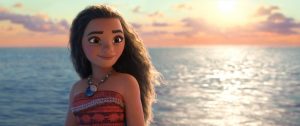Disney animator discusses Moana at USC
In a longstanding tradition of bringing behind the scenes looks at upcoming Disney animated films to USC, head of animation Amy Smeed held a presentation to discuss Moana, the highly acclaimed Disney animated feature that is set to hit theaters on Thursday.

Photo from Walt Disney Animation Studios
Hawaiian rollercoaster ride · Moana, which means “ocean” in Polynesian, is an upcoming 2016 American 3-D computer-animated musical fantasy adventure film that features Disney’s first Hawaiian princess.
Moana is the tale of Pacific Islander Moana (Auli’i Cravalho), a chieftain’s daughter who teams up with the shapeshifting demigod Maui (Dwayne “The Rock” Johnson) to save her people by ending a millennium of unrest at sea. Through her journey, Moana learns about her destiny to restore her people’s lost past of being wayfinders, which are non-instrumental navigators deeply rooted in Polynesian culture. Moana represents the modern-day Disney princess by telling a story of self-discovery and empowerment for its spirited young protagonist.
“[Disney princesses] have evolved over the years,” Smeed said, in an interview with the Daily Trojan. “When you look at stories like Snow White and Cinderella and Sleeping Beauty versus the types of stories that we’re telling today, Moana goes out on her own. She doesn’t need someone to help her.”
As head of animation, Smeed ensured that the film’s enormous team of animators were animating the characters in a consistent manner. Moana was a particularly special project for Smeed herself, as she was appointed to become Disney’s first female head of animation for a feature film. She cited being a female animator as a reason behind her desire to speak at universities like USC.
“The reason why I love going to [events] with lots of students is there aren’t a lot of women in animation,” Smeed said. “I hope when I come to things like this that it’s an inspiration for other women out there to go for it.”
Smeed’s other duties pertained to ensuring that the visions of Moana’s directors, Ron Clements and John Musker, were always being upheld. One of Smeed’s favorite parts of being on the Moana project was working with these two legendary artists, whose prior work includes Disney classics like Aladdin and The Little Mermaid.
“Getting to work with Ron and John was a childhood dream,” Smeed said. “They’re my heroes. Thinking of when I was little watching The Little Mermaid and now being able to sit next to them and work so closely to them was just a huge, huge honor and a dream come true.”
Beyond casting voice actors of Oceanic descent, Clements and Musker were acutely aware of the film’s greater responsibility to authentically portray Polynesian culture. To this end, the directors embarked on multiple trips to Polynesia with a group of artists in tow, meeting with the people whose stories they would be bringing to the big screen.
In an unprecedented move, Disney also set up the Oceanic Trust, a diverse group of linguists, anthropologists and even tattoo artists who advised the filmmakers on how to portray Polynesian culture. Smeed recalled a particularly poignant meeting with a master of wayfinding, Nainoa Thompson.
“Meeting Nainoa Thompson was amazing,” Smeed said. “He had so many stories about sailing and people that he’s met, and wayfinding, which was such a huge part of our story. Having people like him come in and start to learn about a culture that I really didn’t know much about was a huge inspiration.”
Technologically, Moana was also difficult because of the film’s many hair and water effects; in the end, entirely new programs had to be developed to fully encapsulate the film’s artistic vision. However, the results were spectacular — Moana is vibrant, rich with detail and pulsating with visual energy.

